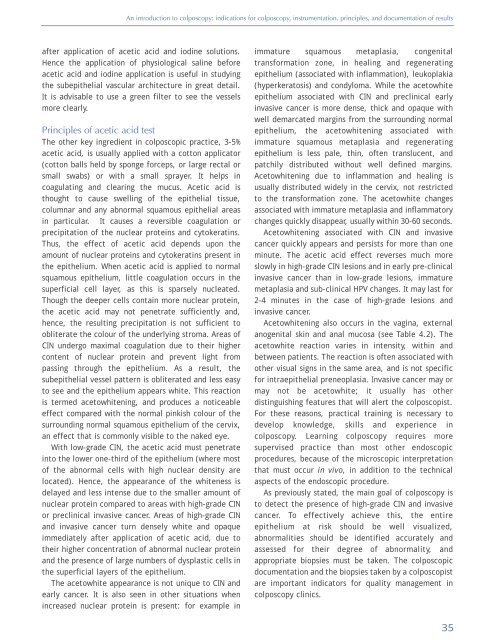Colposcopy and Treatment of Cervical Intraepithelial Neoplasia - RHO
Colposcopy and Treatment of Cervical Intraepithelial Neoplasia - RHO
Colposcopy and Treatment of Cervical Intraepithelial Neoplasia - RHO
Create successful ePaper yourself
Turn your PDF publications into a flip-book with our unique Google optimized e-Paper software.
An introduction to colposcopy: indications for colposcopy, instrumentation, principles, <strong>and</strong> documentation <strong>of</strong> results<br />
after application <strong>of</strong> acetic acid <strong>and</strong> iodine solutions.<br />
Hence the application <strong>of</strong> physiological saline before<br />
acetic acid <strong>and</strong> iodine application is useful in studying<br />
the subepithelial vascular architecture in great detail.<br />
It is advisable to use a green filter to see the vessels<br />
more clearly.<br />
Principles <strong>of</strong> acetic acid test<br />
The other key ingredient in colposcopic practice, 3-5%<br />
acetic acid, is usually applied with a cotton applicator<br />
(cotton balls held by sponge forceps, or large rectal or<br />
small swabs) or with a small sprayer. It helps in<br />
coagulating <strong>and</strong> clearing the mucus. Acetic acid is<br />
thought to cause swelling <strong>of</strong> the epithelial tissue,<br />
columnar <strong>and</strong> any abnormal squamous epithelial areas<br />
in particular. It causes a reversible coagulation or<br />
precipitation <strong>of</strong> the nuclear proteins <strong>and</strong> cytokeratins.<br />
Thus, the effect <strong>of</strong> acetic acid depends upon the<br />
amount <strong>of</strong> nuclear proteins <strong>and</strong> cytokeratins present in<br />
the epithelium. When acetic acid is applied to normal<br />
squamous epithelium, little coagulation occurs in the<br />
superficial cell layer, as this is sparsely nucleated.<br />
Though the deeper cells contain more nuclear protein,<br />
the acetic acid may not penetrate sufficiently <strong>and</strong>,<br />
hence, the resulting precipitation is not sufficient to<br />
obliterate the colour <strong>of</strong> the underlying stroma. Areas <strong>of</strong><br />
CIN undergo maximal coagulation due to their higher<br />
content <strong>of</strong> nuclear protein <strong>and</strong> prevent light from<br />
passing through the epithelium. As a result, the<br />
subepithelial vessel pattern is obliterated <strong>and</strong> less easy<br />
to see <strong>and</strong> the epithelium appears white. This reaction<br />
is termed acetowhitening, <strong>and</strong> produces a noticeable<br />
effect compared with the normal pinkish colour <strong>of</strong> the<br />
surrounding normal squamous epithelium <strong>of</strong> the cervix,<br />
an effect that is commonly visible to the naked eye.<br />
With low-grade CIN, the acetic acid must penetrate<br />
into the lower one-third <strong>of</strong> the epithelium (where most<br />
<strong>of</strong> the abnormal cells with high nuclear density are<br />
located). Hence, the appearance <strong>of</strong> the whiteness is<br />
delayed <strong>and</strong> less intense due to the smaller amount <strong>of</strong><br />
nuclear protein compared to areas with high-grade CIN<br />
or preclinical invasive cancer. Areas <strong>of</strong> high-grade CIN<br />
<strong>and</strong> invasive cancer turn densely white <strong>and</strong> opaque<br />
immediately after application <strong>of</strong> acetic acid, due to<br />
their higher concentration <strong>of</strong> abnormal nuclear protein<br />
<strong>and</strong> the presence <strong>of</strong> large numbers <strong>of</strong> dysplastic cells in<br />
the superficial layers <strong>of</strong> the epithelium.<br />
The acetowhite appearance is not unique to CIN <strong>and</strong><br />
early cancer. It is also seen in other situations when<br />
increased nuclear protein is present: for example in<br />
immature squamous metaplasia, congenital<br />
transformation zone, in healing <strong>and</strong> regenerating<br />
epithelium (associated with inflammation), leukoplakia<br />
(hyperkeratosis) <strong>and</strong> condyloma. While the acetowhite<br />
epithelium associated with CIN <strong>and</strong> preclinical early<br />
invasive cancer is more dense, thick <strong>and</strong> opaque with<br />
well demarcated margins from the surrounding normal<br />
epithelium, the acetowhitening associated with<br />
immature squamous metaplasia <strong>and</strong> regenerating<br />
epithelium is less pale, thin, <strong>of</strong>ten translucent, <strong>and</strong><br />
patchily distributed without well defined margins.<br />
Acetowhitening due to inflammation <strong>and</strong> healing is<br />
usually distributed widely in the cervix, not restricted<br />
to the transformation zone. The acetowhite changes<br />
associated with immature metaplasia <strong>and</strong> inflammatory<br />
changes quickly disappear, usually within 30-60 seconds.<br />
Acetowhitening associated with CIN <strong>and</strong> invasive<br />
cancer quickly appears <strong>and</strong> persists for more than one<br />
minute. The acetic acid effect reverses much more<br />
slowly in high-grade CIN lesions <strong>and</strong> in early pre-clinical<br />
invasive cancer than in low-grade lesions, immature<br />
metaplasia <strong>and</strong> sub-clinical HPV changes. It may last for<br />
2-4 minutes in the case <strong>of</strong> high-grade lesions <strong>and</strong><br />
invasive cancer.<br />
Acetowhitening also occurs in the vagina, external<br />
anogenital skin <strong>and</strong> anal mucosa (see Table 4.2). The<br />
acetowhite reaction varies in intensity, within <strong>and</strong><br />
between patients. The reaction is <strong>of</strong>ten associated with<br />
other visual signs in the same area, <strong>and</strong> is not specific<br />
for intraepithelial preneoplasia. Invasive cancer may or<br />
may not be acetowhite; it usually has other<br />
distinguishing features that will alert the colposcopist.<br />
For these reasons, practical training is necessary to<br />
develop knowledge, skills <strong>and</strong> experience in<br />
colposcopy. Learning colposcopy requires more<br />
supervised practice than most other endoscopic<br />
procedures, because <strong>of</strong> the microscopic interpretation<br />
that must occur in vivo, in addition to the technical<br />
aspects <strong>of</strong> the endoscopic procedure.<br />
As previously stated, the main goal <strong>of</strong> colposcopy is<br />
to detect the presence <strong>of</strong> high-grade CIN <strong>and</strong> invasive<br />
cancer. To effectively achieve this, the entire<br />
epithelium at risk should be well visualized,<br />
abnormalities should be identified accurately <strong>and</strong><br />
assessed for their degree <strong>of</strong> abnormality, <strong>and</strong><br />
appropriate biopsies must be taken. The colposcopic<br />
documentation <strong>and</strong> the biopsies taken by a colposcopist<br />
are important indicators for quality management in<br />
colposcopy clinics.<br />
35
















